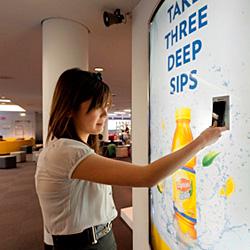This guest post is by Richard Simkins, Convergence Business Director for Posterscope UK. Follow him on Twitter at @rpsimkins
Out of home (OOH) and mobile have proven to be good bedfellows in the past and I believe will continue to show their combined value in today’s convergent, interconnected media landscape.
For a decade brands have connected posters with mobile to offer consumers a richer or simpler experience. SMS, infrared (remember this one?) and Bluetooth have all demonstrated that OOH could drive response and deeper engagement with a brand.
However, while the smartphone has unquestionably changed the game for OOH planning, we believe there are two key ways OOH will work with mobile moving forward.
The possibilities for OOH and mobile
The first is the utilisation of data created by everyone’s mobile footprint to better optimise and target OOH campaigns. We are on the cusp of being able to use anonymised GPS data or advertiser-created in-app data (such as the geography of sales) to better plan our OOH campaigns, or to invisibly schedule better targeted ads on digital OOH screens.
It is therefore foreseeable that one day network data or handset IP addresses could also be used to influence our OOH planning, but for this to even have a chance of coming to fruition there would need to be a seismic shift in attitudes towards the sharing of both companies’ and individuals’ proprietary data.
As such it is practically criminal if your website has not been optimised for viewing on mobile devices, and thought should be given as to how OOH creative and regionality should influence your own SEO and search strategies.
As devices have become more sophisticated, so have the options for connectivity. 3G (soon to be 4G) and WiFi have now come to be expected in many environments (the 150-year-old London Underground is no different), which allows OOH audiences to easily connect to rich digital content such streaming videos, downloading apps or coupons or real time augmented reality overlays onto static poster sites.
Near field communication

Lipton Iced Tea used NFC-enabled ads to generate more Facebook Likes.
However, I believe the real game-changer will be near field communication (NFC) as it has the potential to significantly benefit engagement with, and accountability of OOH due to its simplicity and potential for scale.
NFC chips instruct your phone to take a particular action such as open an app, send a tweet or pay for something. NFC chips can be affixed behind a poster or other object such as a coffee cup sleeve which means that every touchable ambient object or OOH advert can become interactive.
It opens up several exciting opportunities for advertisers. An NFC poster will allow people to automatically submit personal details or buy something. It can facilitate immediate “liking” of brands on Facebook or social payments such as a “pay with a tweet” promotion.
Alternatively NFC can unlock rich content such as quickly downloading movie trailers, a preview track from a new album or the first level of a new game app.
NFC posters also create quantifiable, accountable data for advertisers which allows them to track trends, interaction figures or the resulting online traffic.
There are already an estimated two million NFC phones in the UK and more than 500 million globally. Google claims that it is activating one million Android NFC devices each week around the world.
Regardless of whether Apple incorporates NFC into the iPhone 5 (which is hotly anticipated), it is clear that this technology has arrived, but there is currently a big knowledge gap.
Bringing NFC to the fore
In partnership with Clear Channel Outdoor, our research into NFC found that even early adopters don’t really understand what NFC is but once it was demonstrated to them they liked the idea of being able to directly interact with a poster site using their phone.
Our same research suggested that network operators, phone manufacturers, banks, retailers and yes, marketers have a responsibility to inform consumers as to how NFC works and of its benefits.
Companies driving the NFC agenda such as Samsung and Google and interim innovations like Barclaycard PayTag are therefore to be commended, but I believe that it is now time for media planners and advertisers to step up and start adopting this technology.
As Malcolm Gladwell described in The Tipping Point, a social epidemic may fail to take hold if the context isn’t right, and in the case of NFC there are a number of factors that could still derail this technology.
Poor experiences (marketers) or insecure transactions (banks, network operators) are likely to turn consumers away from NFC, as would fragmented experiences that result from battles over “ownership” of the platform (network operators vs handset manufacturers vs banks).
Then there is the Apple question: what will they do? It’s unlikely that the company will give up the opportunity to create a new transactional ecosystem that has the potential to span its other platforms, but will Apple isolate itself from the rest of the market or collaborate with its competitors?
Mobile technology is developing faster than consumer adoption, which in turn media planners are barely keeping up with. We need to be more pioneering and ambitious with our OOH planning, otherwise the opportunities there are in this space may never be realised.
